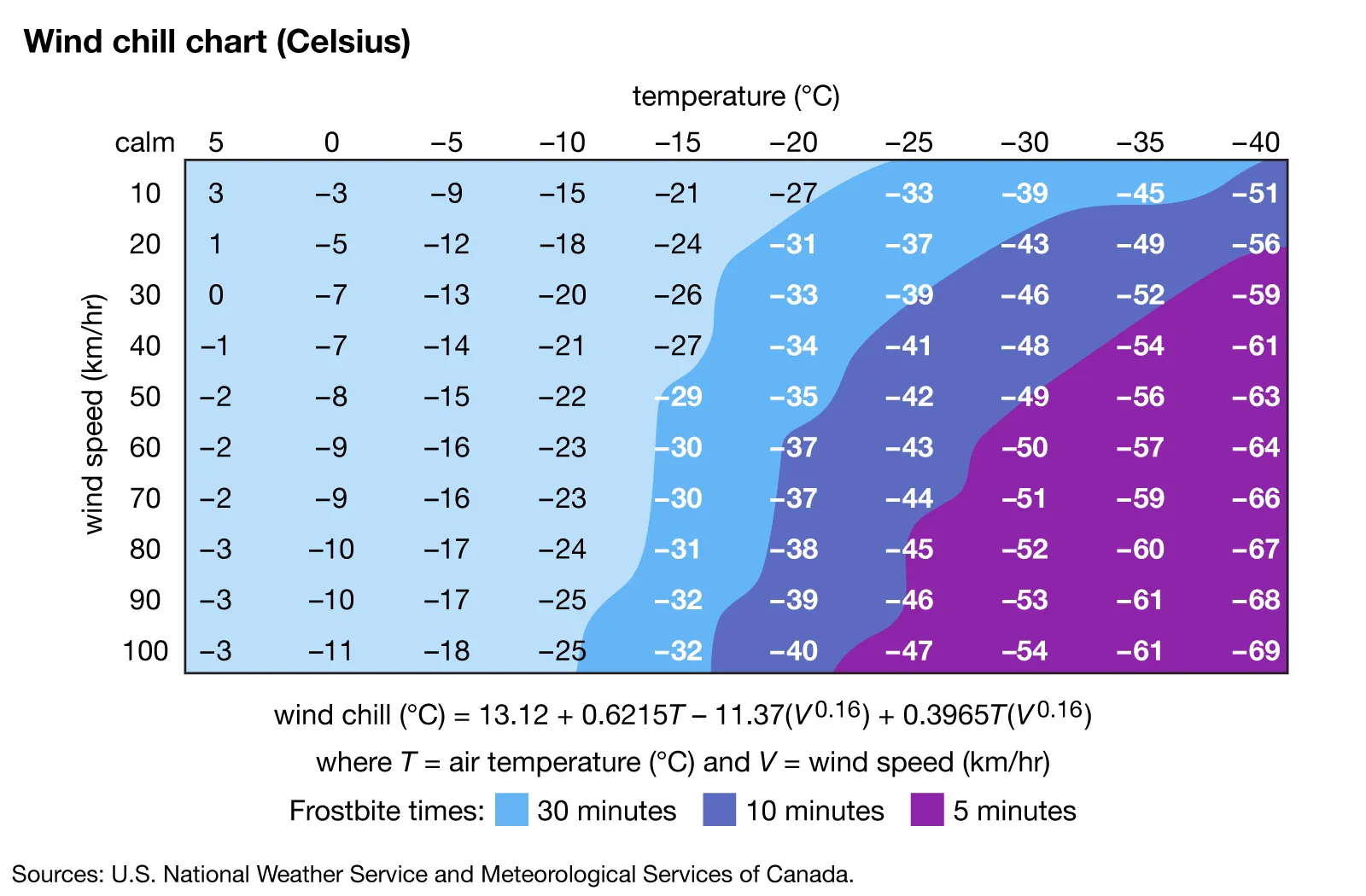Astronomy Exam One
1/40
There's no tags or description
Looks like no tags are added yet.
Name | Mastery | Learn | Test | Matching | Spaced |
|---|
No study sessions yet.
41 Terms
What does the term “environmental” refer to?
aspects that focus on the relationship between people and the natural environment
Hypothesis vs Theory vs Paradigm
tentative or untested explanation
vs
tested multiple times and confirmed hypothesis (describes a specific phenomena, like natural selection)
vs
a theory that explains a large number of interrelated aspects of the natural world (a general assumption about the world, like evolutionary biology)
What hypothesis is the generally accepted idea of how our solar system formed around the same time?
What does this hypothesis say the solar system evolved from?
When and how did the solar system assume a flat disc shape with the protosun (pre-Sun) at the center?
What did inner planets begin to form from?
What did outer planets begin to form from?
Solar Nebula Hypothesis
Solar nebula (enormous rotating cloud containing mostly hydrogen and helium)
5 billion years ago, the solar nebula contracted
metallic rocky clumps
fragments with high percentage of ices
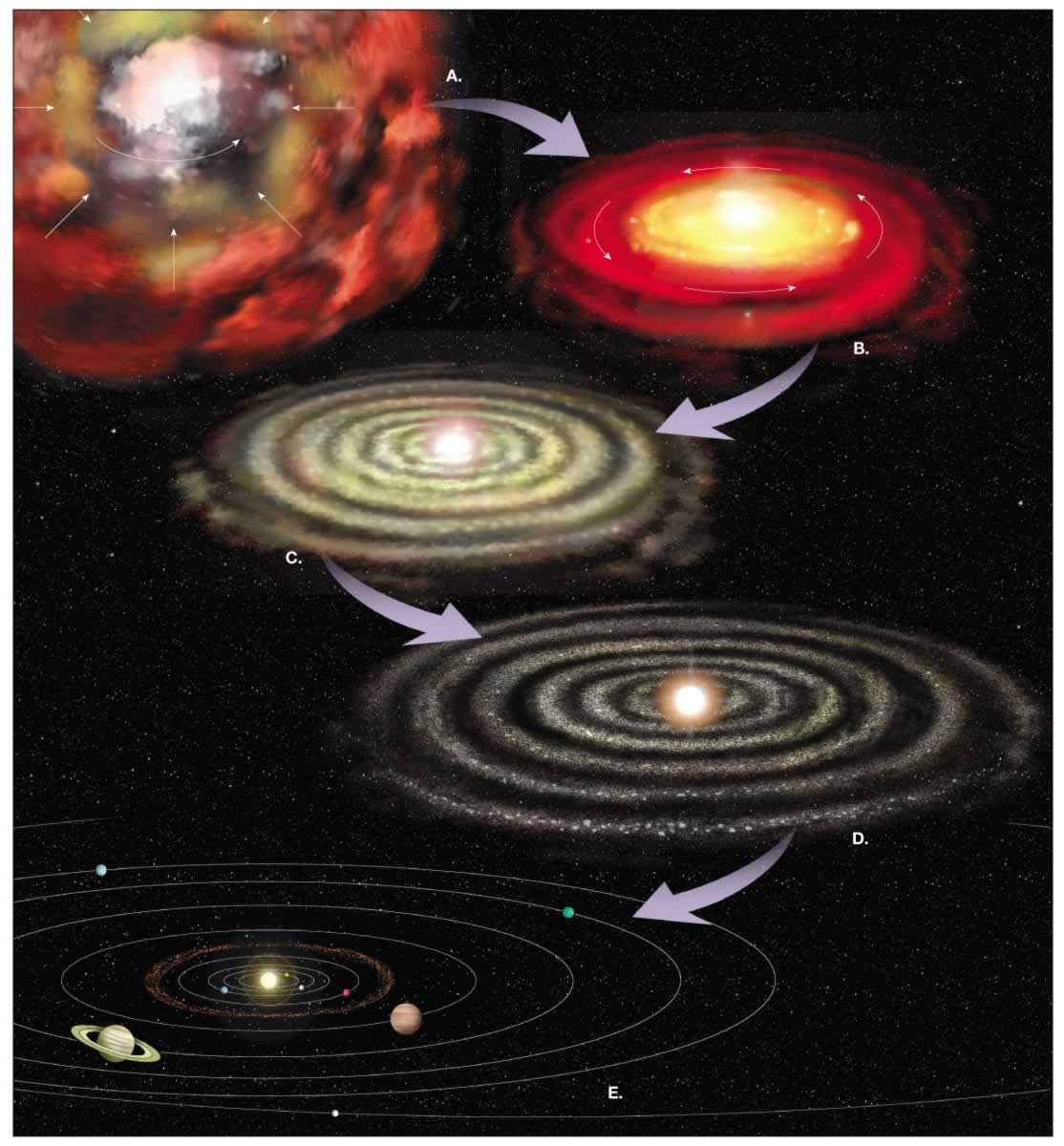
What is the approximate age of the Earth?
4.5 billion years
As the Earth formed, what caused temperatures to increase?
What is differentiation?
As a result of differentiation, what materials sunk towards the center of the Earth and what materials rose toward the surface?
What formed the Earth’s primitive atmosphere?
the decay of radioactive elements and heat from high-velocity impacts
the process where a planet’s materials separate by density to form its internal structure
iron and nickel melted and sunk towards center (forming the cores); lighter rocky components floated up (forming the crusts)
gaseous material that escaped from Earth’s interior
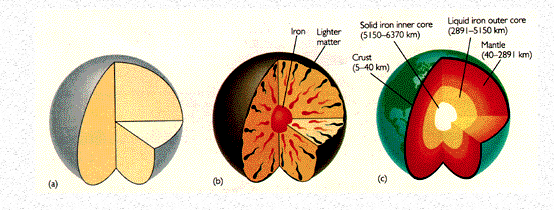
What is a system?
What are the different systems of the Earth?
any size group of interacting parts that form a complex whole
hydrosphere
atmosphere
biosphere
solid earth
What is the most prominent feature of the hydrosphere?
How much of the Earth’s surface (what percentage) does the ocean cover?
How much of the Earth’s water does the ocean contain?
What does the hydrosphere also include other than the ocean?
ocean
71% (mid-to-low seventies; number may be different on test)
97%
streams
lakes
glaciers
groundwater
What system is the smallest of the spheres? What is this system characterized as? One half of this system lies below what distance?
atmosphere
thin, tenuous blanket of air
below 5.6 kilometers (3.5 miles)
What does the biosphere include? Where is the biosphere mainly concentrated at?
all life forms
near the surface in a zone that extends from ocean floor to several kilometers into the atmosphere
What is the solid earth sphere based on?
What does it consist of?
What are the divisions of the outer portion based on?
What is considered the rigid outer layer?
How is the Earth’s surface divided by?
compositional differences
crust, mantle, and core
how materials behave
lithosphere
continents and ocean basins
Open systems vs Closed systems
both energy and matter flowing into and out of the system (e.g. a river system, climate, plant/animal system)
vs
self-contained; nothing permanently leaves the system (e.g. hydrologic cycle, carbon cycle, nitrogen cycle)
Negative feedback mechanisms vs Positive feedback mechanisms
resist change and stabilize the system (e.g. friction)
vs
enhance the change to the system (greenhouse gasses)
What are the two sources of energy for the Earth?
Which source of energy drives external processes (weather, ocean and erosional processes)?
Which source of energy drives internal processes (volcanoes, earthquakes, and mountain building)?
(1) the Sun and (2) Earth’s radioactive interior
the Sun
radioactivity
Renewable resources vs Nonrenewable resources
can be replenished “rapidly” (e.g. plants and energy from water and wind)
vs
cannot be replenished “rapidly” (e.g. metals and fuels)
What are some reasons as to why Earth Science is important?
rate of mineral and energy usage has climbed more rapidly than overall growth of population
environmental problems that are either human-induced or humans accentuated
understanding natural disasters
Human-induced environmental problems vs Human-accentuated environmental problems
problems that are actually caused by humans (e.g. urban air pollution and ozone depletion)
vs
problems that humans contribute to but don’t directly cause (e.g. acid rain and global warming)
Weather vs Climate
what is going on in atmosphere over a short period of time and is constantly changing
vs
over a long period of time; generalized, composite of weather
What is an air parcel?
an imaginary blob of air that contains different gases
What is the most abundant gas in the atmosphere?
Second most abundant?
Third most abundant?
How much of atmosphere consists of carbon dioxide?
What does carbon dioxide help do?
Nitrogen (N) - 78%
Oxygen (O2) - 21%
Argon
0.036%
absorbs heat energy from Earth
What is an aerosol (AKA particulates or condensation nuclei)?
What can aerosols do/affect?
Why are aerosols important?
What sources do aerosols originate from?
tiny solid or liquid particles (e.g. dust or water droplets)
can reflect light (cool atmosphere) or absorb light (warm atmosphere)
color sunrise and sunsets
without them, you cannot form clouds (you can’t allow water vapor to condense)
dust storms, volcanic eruptions, urban air pollution, etc.
Why is water vapor considered a “perfect criminal”?
What percent does it take up the air’s volume?
Why is water vapor important?
it is the most efficient greenhouse gas because it doesn’t leave a measurable chemical trace
4%
forms clouds and precipitation
absorbs heat energy from Earth
What is an ozone?
Where is ozone concentrated at above the surface?
Why is ozone important?
How does human activity deplete the ozone?
Three atoms of oxygen (O3)
10-15 kilometers above surface
absorbs harmful UV radiation
humans add chlorofluorocarbons (CFCs)
What is atmospheric pressure?
What is the average sea level pressure?
What does pressure decrease with?
One-half of the atmosphere is below how many miles?
What percent of the atmosphere is below 10 miles (16 km)?
How much of the atmosphere is below jets when they fly?
the weight of the air above
slightly more than 1000 millibars; about 14.7 pounds per square inch
altitude
3.5 miles (5.6 km)
90%
2/3
What is the bottom layer of the atmosphere called?
What usually occurs in this layer?
What happens to temperature as altitude increases (and what is this phenomena called)?
What is the average temperature difference between altitude (Celsius to kilometer, Fahrenheit to feet)?
What is the average height/thickness of this layer (and what is the height varied with)?
What is the outer boundary called?
troposphere
weather
temperature decreases (called environmental lapse rate)
6.5˚C per kilometer (average)
3.5˚F per 1000 feet (average)
12 km (varies with latitude)
tropopause

What is the second layer (from bottom to top) of the atmosphere called?
What is the range of height this layer occupies?
What happens to temperature as altitude increases?
What is the outer boundary called?
stratosphere
12 km - 50 km
temperature increases
stratopause
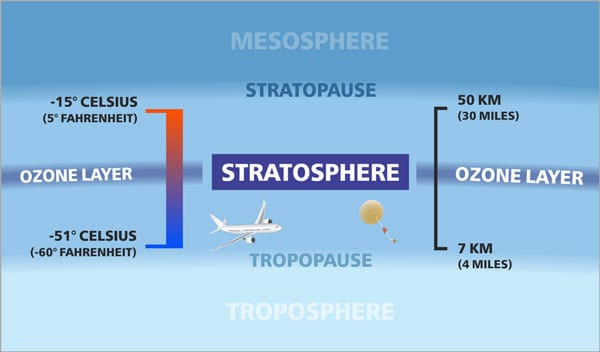
What is the third layer (from bottom to top) of the atmosphere called?
What is the range of height this layer occupies?
What happens to the temperature as altitude increases?
What is the outer boundary called?
mesosphere
50 km - 80 km
temperature decreases
mesopause
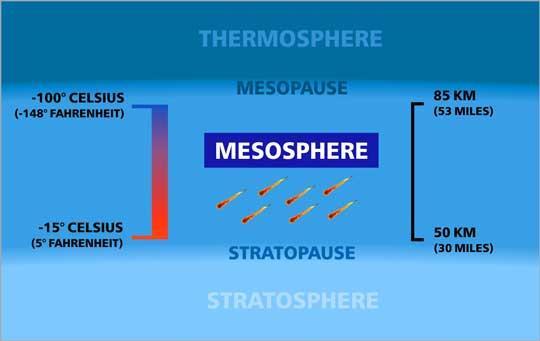
What is the last layer (from bottom to top) of the atmosphere called?
What is the upper limit of this layer?
How much does this layer take up the atmosphere’s mass (in general)?
Are gases moving at high or low speeds?
thermosphere
no well-defined upper limit
makes only a fraction of atmosphere’s mass
high speeds
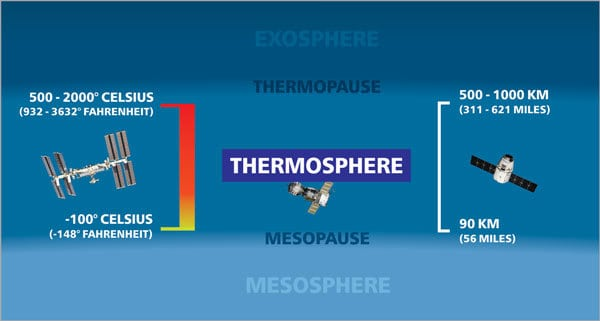
Conduction vs Convection vs Radiation
heat transfer through molecular activity
happens in solids
faster vibrating molecules have more energy and therefore give off more heat, which can be transferred to cooler objects (requires direct touch)
vs
mass movement of heat within a fluid (liquid/air)
usually vertical motions
hot fluid molecules move up, cold molecules move down, forming circulatory flow of heat
vs
heat transfer through electromagnetic waves
consists of different wavelengths
can travel through a vacuum (needs no medium to carry it) at 300,000 km (186,000 miles) per second

Heat is always transferred from ___ to ___ objects.
warmer; cooler
What are the different wavelengths that radiation can travel through?
gamma (very short waves)
X-rays
Ultraviolet (UV)
Three levels: A, B, and C
Visible
ROYGBIV
Infrared
Microwaves and radio waves (radio is longest waves)

As wavelength decreases (for radiation), what happens to the energy carried per wave?
According to basic laws of radiation, do all objects, at whatever temperature, emit radiation?
According to basic laws of radiation, which radiates more totaled energy per unit area: hotter or cooler objects?
According to basic laws of radiation, the hotter a radiating body gets, what happens to the wavelength of maximum radiation?
According to basic laws of radiation, objects that are good absorbers of radiation are also good at what?
energy carried per wave decreases
yes
hotter objects emit more radiation
the wavelength gets shorter
emitting radiation
Atmosphere is largely ___ to incoming solar radiation.
transparent
What are the three different ways the atmosphere affects incoming radiation from the Sun?
What is albedo?
Reflection (light bounces back from a surface at the same angle it hit)
Scattering (light is bounced out at different angles due to interactions with small particles)
Absorption (light energy is taken in by a material and converted into another form, like heat)
percent that is reflected (objects that don’t reflect a lot of light have a low albedo [like black shirts], while objects that reflect a lot of light have a high albedo [like white shirts])
What is terrestrial radiation?
What is terrestrial radiation absorbed by?
How is the lower atmosphere heated?
What is the heating of the atmosphere called?
the long-wavelength radiation coming from the planet due to its temperature
Carbon dioxide and water vapor in the atmosphere
from the Earth’s surface
Greenhouse effect

How does the greenhouse effect work? (List three key steps).
What characterizes a greenhouse gas?
visible light passes through atmosphere
surface absorbs visible light and emits thermal radiation in infrared
greenhouse gases absorb and re-emit infrared radiation, thereby heating the lower atmosphere
any gas that absorbs infrared
must contain molecules with two different types of elements (CO2, H2O, CH4)
it CANNOT be a molecule with one or two atoms of the same element (O2, N2)
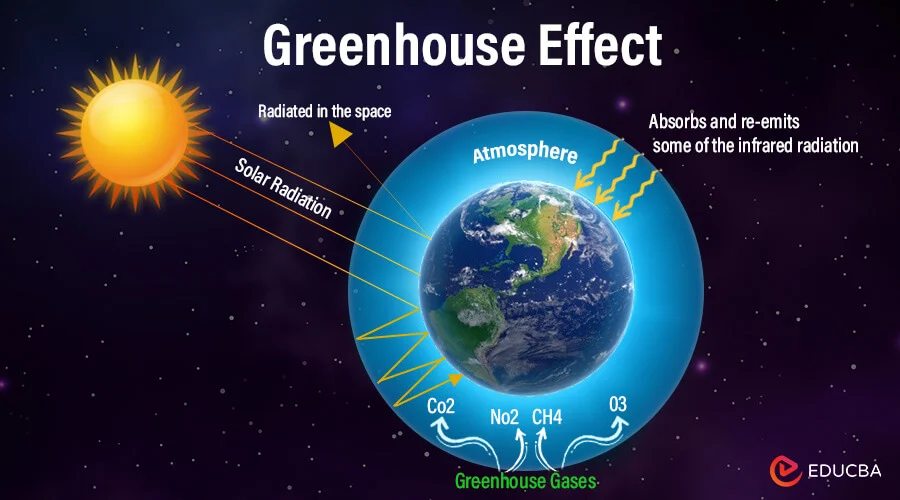
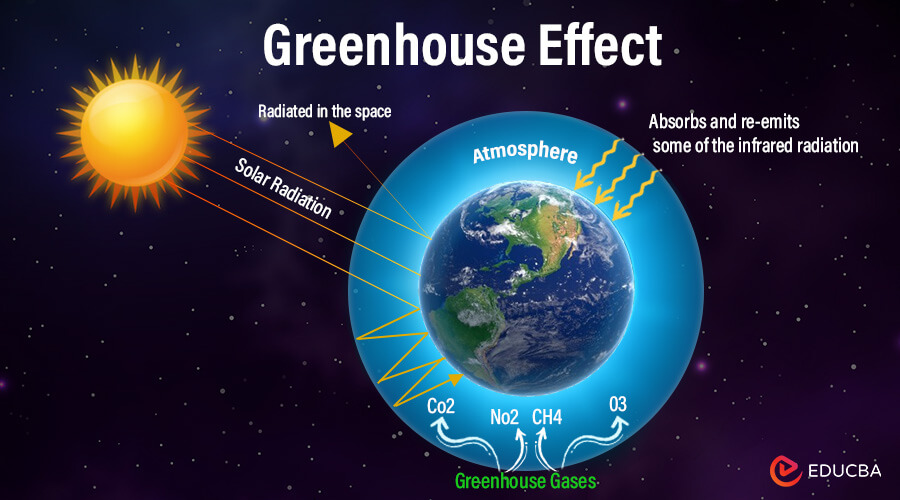
What is air temperature a measure of?
How do molecules move in a cold volume of air? Warm volume?
What are some of the measurements that can be taken of temperature?
What are some important factors that influence the rate of heat loss from the body (consequently influences the human sensation of temperature)?
average speed of molecules
cold volume—molecules move more slowly and crowd closer together; warm volume—molecules move faster and farther apart
Measurements of temperature:
daily maximum and minimum
daily/monthly/annual mean
daily/monthly/annual range
Factors that influence sensation of temperature:
air temperature
relative humidity
wind speed
sunshine
What is the boiling and freezing point of water in Fahrenheit?
What is the boiling and freezing point of water in Celsius?
What is the boiling and freezing point of water in Kelvin?
Freezing: 32°F
Boiling: 212°F
Freezing: 0°C
Boiling: 100°C
Freezing: 273.15 Kelvin
Boiling: 373.15 Kelvin
What is the most important control of temperature?
What are other important controls?
solar radiation
differential heating of land and water (land heats and cools more rapidly than water; land also gets hotter and cooler than water)
altitude
geographic position
cloud cover
albedo
What is an isotherm?
What do isotherms show?
How are temperatures adjusted on temperature maps?
What two months are used for analysis because they represent temperature extremes?
a line connecting places of equal temperature
ocean currents
adjusted to sea level
January and July

What does heat index measure?
How is heat index calculated?
Why are heat indexes important?
how hot it feels outside by comparing air temperature and humidity
uses a table with a formula that takes into account relative humidity and dry bulb temperature
it indicates how dangerous the heat can be than just the air temperature by telling people how much heat their bodies can handle
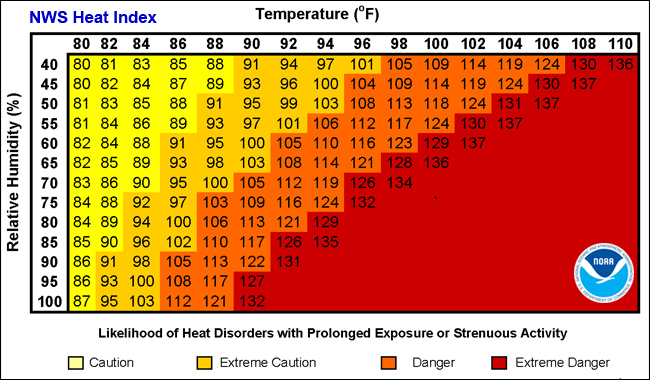
What do wind chills measure?
How are wind chills calculated?
Why are wind chills important?
how cold it feels outside due to wind and temperature
uses a table with a formula that takes into account the temperature and wind speed
it can be a major factor in health hazards like frostbite and hypothermia
